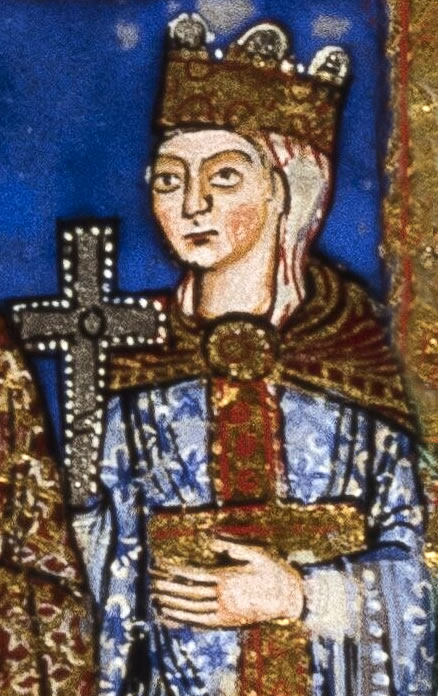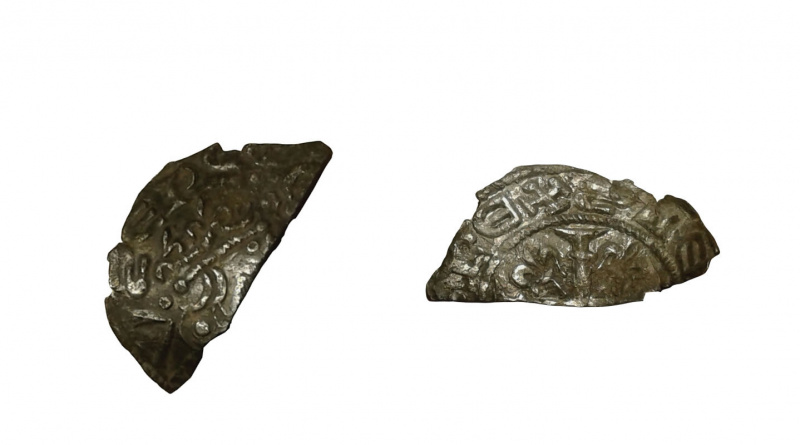The story of Henry Murdac – a penny of Stephen
Shaughn Tyreman is the finder of this cut halfpenny. The obverse/reverse die combination is certainly unusual but Shaughn had managed to identify it as a coin of Henry Murdac.
If all the imagery was visible then on the obverse would be a crowned bust facing right, with annulets on a collar below the chin and a crozier and a star in front of the face. On this side the full legend would read hENRICVS EPC+.
On the reverse is a cross pattee over a saltire fleury within the inner circle and if the whole of the legend was visible it would read +STEPhANVS REX. Fairly obviously, the reverse legend points towards this coin being struck during the reign of Stephen. However, rather than it being an official issue, it was struck for a high ranking member of the Catholic Church. Coins of this type used to be attributed to Henry of Blois, Bishop of Winchester, but are now believed to have been issued by Henry Murdac when he was Archbishop of York.
Historical Background
Henry I
Henry I had only one legitimate son, William, who would have been the next king when Henry died. Tragically, William was drowned in November of 1120.

A 12th-century depiction of Matilda
Henry I acknowledged no less than 20 illegitimate children but on the death of William his only legitimate child was his daughter, Matilda, who at the tender age of 12 years was married in 1114 to the Emperor Henry V of Germany. However, her husband died in 1125 and despite the fact that she was well settled in Germany, Matilda was ordered by her father to return to the English court. Henry then made the leading magnates swear to accept her as their ruler when he died. In an effort to continue an alliance already in place, in 1128 Matilda was married to the much younger Geoffrey Plantagenet, Count of Anjou.
Stephen grasps the throne.
On the death of Henry I in December of 1135 there were few Anglo-Norman lords who wished to be ruled over by a woman and her Angevin husband. It is said that a group of barons favoured the election of Theobald of Blois as the next king. However, acting with great speed, Theobald’s younger brother, Stephen, was crowned king on 22 December. Knowing that dived loyalties could lead to war, those who had supported Theobald switched their allegiance to Stephen. In blunt terms, Matilda must have been spitting blood when news of this reached her.
Civil war
For a couple of years things were relatively quiet and peaceful but in 1138 Geoffrey of Anjou invaded Normandy, David I of Scotland already had control of much of the north of England, and Robert of Gloucester (Matilda’s half-brother) started a rebellion in the west; the following year Matilda landed on the south coast of England with a party of supporters. This was the start of the period that became known as the anarchy. Every part of England wasn’t involved and armed conflict was sporadic rather than continuous but the country lacked the strength and authority of a united central government. Therefore, some barons did much as they pleased and it was not unusual for them to change sides more than once. Not only were the barons involved but so too were some high ranking members of the Church. For example, Stephen’s younger brother, Henry, was Bishop of Winchester. This Henry had hoped to become Archbishop of Canterbury but Stephen refused to grant him this position; instead he was made papal legate, which allowed him to dominate the English Church as the Pope’s representative.
Henry Murdac
Henry Murdac was a friend of Archbishop Thurstan of York, who promoted him to the cathedral chapter of York Minster. However, he left when he was invited by Bernard of Clairvaux to become a Cistercian monk at Clairvaux Abbey in France. It was there that he developed a friendship with the man who became Pope Eugene III. Later on Murdac was appointed as the first Abbot of Vauclair Abbey in Laon but in 1144 he returned to Yorkshire as the Abbot of Fountains Abbey.

BTFEE4 Stained glass window depicting St William of York Archbishop of York Minster from 1141 onwards Bradfield South Yorkshire U.K
In January of 1141 William Fitzherbert was elected as Archbishop of York. Fitzherbert was the nephew of Stephen and his election was opposed by the Cistercian monasteries of Yorkshire and by the archdeacons of York. Additionally, the Archbishop of Canterbury did not recognise his election due to allegations of simony, the acquisition of his position through bribery and of interference in the election by Stephen. Fitzherbert swore an oath that the charges were false and Henry of Blois, acting as papal legate, found him innocent and he was then consecrated as archbishop on 26 September 1143.
The appointment of Eugene (a Cistercian) as Pope in 1145 proved to be problematic for William Fitzherbert. Bernard of Clairvaux tried very hard to have Fitzherbert suspended. Late in 1146 Pope Eugene decided that Fitzherbert had not been validly consecrated and he was suspended from office. He was finally deposed early in 1147 and the decision was confirmed at the Council of Reims on 21 March 1148. This led to another election and Henry Murdac was the successful candidate.
Stephen refused to accept Fitzherbert’s deposition and prevented Murdac from entering York. In 1149 David I of Scotland invaded the north of England (again!) and in this venture he received the support of Henry Murdac. The invasion was supposed to be in order to place David’s nephew, Henry Plantagenet (later Henry II), on the throne but could have had more to do with strengthening of David’s own position whilst England was weak. Murdac may have thought that if the Scots reached York then he might be installed as archbishop.
In 1150 Murdac was finally recognised by Stephen as Archbishop of York. However, he still lacked support in the city and he continued to reside at Ripon. Eventually, in January of 1151 he was able to enter York. Stephen wanted his son, Eustace, to be crowned king, so that his succession would be assured and hoped that Murdac would intercede with Pope Eugene to bring this about. Murdac did travel to Rome in 1151 but was unable to secure permission from the Pope for Eustace’s coronation.
Henry Murdac died at Beverley in Yorkshire on 14 October 1153 and shortly afterwards, on 20 December, the reappointment of William Fitzherbert was confirmed.
The civil war ends
Eustace, the son and heir of Stephen, also died in 1153. Theobald of Canterbury and Henry of Winchester then led a movement to draw King Stephen and Henry Plantagenet together. An agreement was reached whereby Stephen would remain king until his death, his younger son would inherit his baronies, and Henry would inherit his kingdom.
On 25 October 1154 Stephen died and on 19 December Henry Plantagenet, son of the Empress Matilda and Geoffrey Plantagenet and grandson of King Henry I, was crowned as Henry II. His charters would include the titles of King of the English, Duke of the Normans and Aquitanians and Count of the Angevins. He would rule until 1189 and be one of the strongest, most imaginative and innovative kings of England. It is therefore a pity that a man with such outstanding qualities did not pay more attention to the coinage of England. The quality of much of the currency struck during the reign of Stephen wasn’t good but it sank to even greater depths during the first coinage of Henry II. As detectorists and numismatists know only too well, clearly struck examples of the cross and crosslets (‘Tealby’) coinage are few and far between. Henry II has gone down in history as a great king but most of his early coins are absolutely awful!
Shaughn’s find
In numismatic reference works the best possible specimens are used to illustrate the reigns, types and varieties of coins. The rarity of coins of Henry Murdac is highlighted by the fact that the same specimen is used to illustrate J. J. North’s English Hammered Coinage and Spink’s Standard Catalogue. This coin doesn’t have much wear but has a large piece missing from its edge. When the late R. P. Mack wrote ‘Stephen and the Anarchy’ (British Numismatic Journal, 1966) only two specimens were known, one of which was purchased in York many years previously for the equivalent of 5p. Today I would guess that around half a dozen are known.
When were these coins struck? Murdac was recognised as Archbishop in 1150 but only entered York in January of 1151 and died on 14 October 1153. Therefore, the most probable time of issue is between the last two dates. This seems more likely than any earlier period, even though Murdac had been Archbishop of York since 1148.
Valuation
Both sides of Shaughn’s find would grade VF for the period but it has a slight edge chip. Significant plus points include its great rarity and the fact that it was struck during a particularly interesting period in English history. Cut halfpennies are worth far less than whole pennies but this one is so interesting and unusual that I would place upon it a pre-sale auction estimate no lower than £600 – £800.

